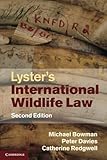Lyster's international wildlife law
Material type: TextPublication details: Cambridge Cambridge University Press 2010Edition: 2ndDescription: xxvi,755p. 24 cmISBN:
TextPublication details: Cambridge Cambridge University Press 2010Edition: 2ndDescription: xxvi,755p. 24 cmISBN: - 9780521527293
- 346.469516 22 BO-L
- K3525 .B69 2010
 Print
List(s) this item appears in:
Global Library Recent Acquisitions September 2014(Part-1)(List)
Print
List(s) this item appears in:
Global Library Recent Acquisitions September 2014(Part-1)(List)
| Item type | Home library | Collection | Shelving location | Call number | Materials specified | Status | Date due | Barcode | |
|---|---|---|---|---|---|---|---|---|---|
 Print
Print
|
OPJGU Sonepat- Campus | General Books | Main Library | 346.469516 BO-L (Browse shelf(Opens below)) | Available | 129620 |
Includes bibliographical references and index.
Machine generated contents note: Part I. Foundations of International Wildlife Law: 1. The historical evolution of international wildlife law; 2. Wildlife and the international legal system; 3. The philosophical foundations of international wildlife law; 4. Implementation and enforcement of international wildlife law; Part II. Species Regulation: 5. Fish; 6. The International Convention for the Regulation of Whaling; 7. Birds; Part III. Regional Wildlife Regulation: 8. The Convention on Nature Protection and Wildlife Preservation in the Western Hemisphere; 9. The African Convention on the Conservation of Nature and Natural Resources; 10. The Convention on the Conservation of European Wildlife and Natural Habitats; 11. Polar regions; 12. Other regional and sub-regional arrangements; Part IV. Global Wildlife Regulation: 13. The Ramsar Convention on Wetlands; 14. World Heritage Convention; 15. The Convention on International Trade in Endangered Species of Wild Fauna and Flora; 16. The Convention on the Conservation of Migratory Species of Wild Animals; Part V. Biological Diversity: A New Perspective on Wildlife Regulation: 17. The Biodiversity Convention and biosafety protocol; 18. Deserts, forests and mountains; Part VI. Cross-Sectoral Issues in Wildlife Regulation: 19. Wildlife and trade; 20. Wildlife and welfare; 21. Wildlife and pollution; Part VII. Conclusion: 22. Final reflections.
"The development of international wildlife law has been one of the most significant exercises in international law-making during the last fifty years. This second edition of Lyster's International Wildlife Law coincides with both the UN Year of Biological Diversity and the twenty-fifth anniversary of Simon Lyster's first edition. The risk of wildlife depletion and species extinction has become even greater since the 1980s. This new edition provides a clear and authoritative analysis of the key treaties which regulate the conservation of wildlife and habitat protection, and of the mechanisms available to make them work. The original text has also been significantly expanded to include analysis of the philosophical and welfare considerations underpinning wildlife protection, the cross-cutting themes of wildlife and trade, and the impact of climate change and other anthropogenic interferences with species and habitat. Lyster's International Wildlife Law is an indispensable reference work for scholars, practitioners and policy-makers alike"--
"It is difficult to obtain a clear understanding of any legal topic without some sense of the chronology of key developments and the wider historical context out of which they emerged. Areas of legal regulation tend to evolve not in a meticulously planned, orderly fashion but as an unstructured series of responses to perceived problems, and against the backdrop of the social and political realities of the day. Early attempts to regulate whaling and sealing, for example, must be viewed in the light of the considerable economic importance once exhibited by such industries, which may be difficult to credit from a purely contemporary perspective. More generally, the political emphasis placed on conservation policy and legal regulation has fluctuated significantly over time, reflecting the prevailing preoccupations of the international community during successive eras"--
There are no comments on this title.

